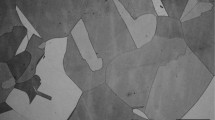Abstract
Searching for a possibility of registering polymorphic transformations in cobalt under rapid extension, we measured free-surface velocity profiles of high-purity cobalt samples subjected to shock-wave loading at temperatures of 20–400 °C. In this temperature range, the spalling strength of cobalt at rates of its extension of 105 – 106 sec−1 was measured, and the relaxation properties of this material under compression in the shock-wave front were estimated. In the experiments, we failed to observe expected wave-profile anomalies due to possible high-temperature polymorphic transformation of cobalt under extension. Most probably, the volume change due to transformation is too small to exert notable influence on the wave-profile structure. Key words: high-purity cobalt, shock compression, phase transformations, spalling strength, temperature.
Similar content being viewed by others
REFERENCES
G. I. Kanel', S. V. Razorenov, A. V. Utkin, and V. E. Fortov, Shock-Wave Phenomena in Condensed Media [in Russian], Yanus-K, Moscow (1996).
D. Kennedy and R. Newton, in: V. Paul and Warschauer (eds.), Solids under Pressure, New York (1963).
J. R. Asay and L. M. Barker, “Interferometric measurement of shock-induced internal particle velocity and spatial variations of particle velocity," J. Appl. Phys., 45, No. 6, 2540 (1974).
K. Baumung, H. Bluhm, B. Goel, et al. “Shock-wave physics experiments with high-power proton beams," Laser Part. Beams, 14, No. 2 (1996).
D. D. Bloomquist and S. A. Sheffield, “Optically recording interferometer for velocity measurements with subnanosecond resolution," J. Appl. Phys., 54, 1717 (1983).
G. I. Kanel, S. V. Razorenov, A. A. Bogatch, et al., “Spall fracture properties of aluminum and magnesium at high temperatures," J. Appl. Phys., 79, No. 11, 8310–8317 (1996).
J. W. Swegle and D. E. Grady, “Shock viscosity and the prediction of shock wave rise times," J. Appl. Phys., 58, 692–701 (1985).
S. A. Novikov, I. I. Divnov, and A. G. Ivanov, “Fracture study of steel, aluminum, and copper under explosive loading," Fiz. Metal. Metalloved., 25, No. 4, 608–615 (1964).
S. P. Marsh (ed.), LASL Shock Hugoniot Data, Univ. California Press, Berkeley (1980).
M. W. Guinan and D. J. Steinberg, “Pressure and temperature derivatives of the isotropic polycrystalline shear modulus for 65 elements," J. Phys. Chem. Solids, 35, 1501–1512 (1974).
A. P. Babichev et al., Physical Quantities: Handbook [in Russian], Énergoatomizdat, Moscow (1991).
Author information
Authors and Affiliations
Rights and permissions
About this article
Cite this article
Razorenov, S.V., Kanel', G.I., Kramshonkov, E.N. et al. Shock Compression and Spalling of Cobalt at Normal and Elevated Temperatures. Combustion, Explosion, and Shock Waves 38, 598–601 (2002). https://doi.org/10.1023/A:1020303004747
Issue Date:
DOI: https://doi.org/10.1023/A:1020303004747



